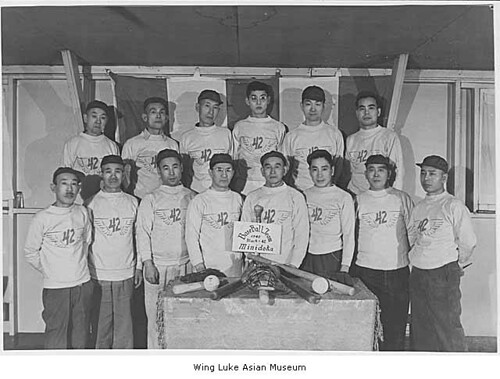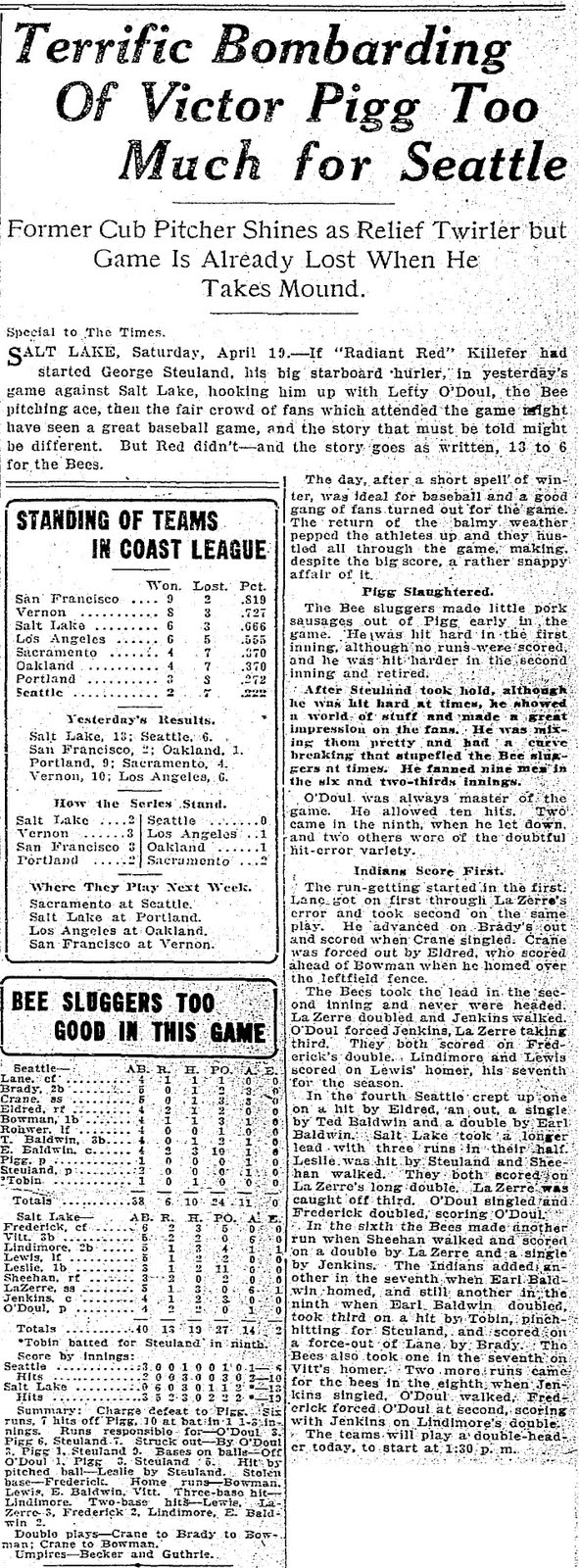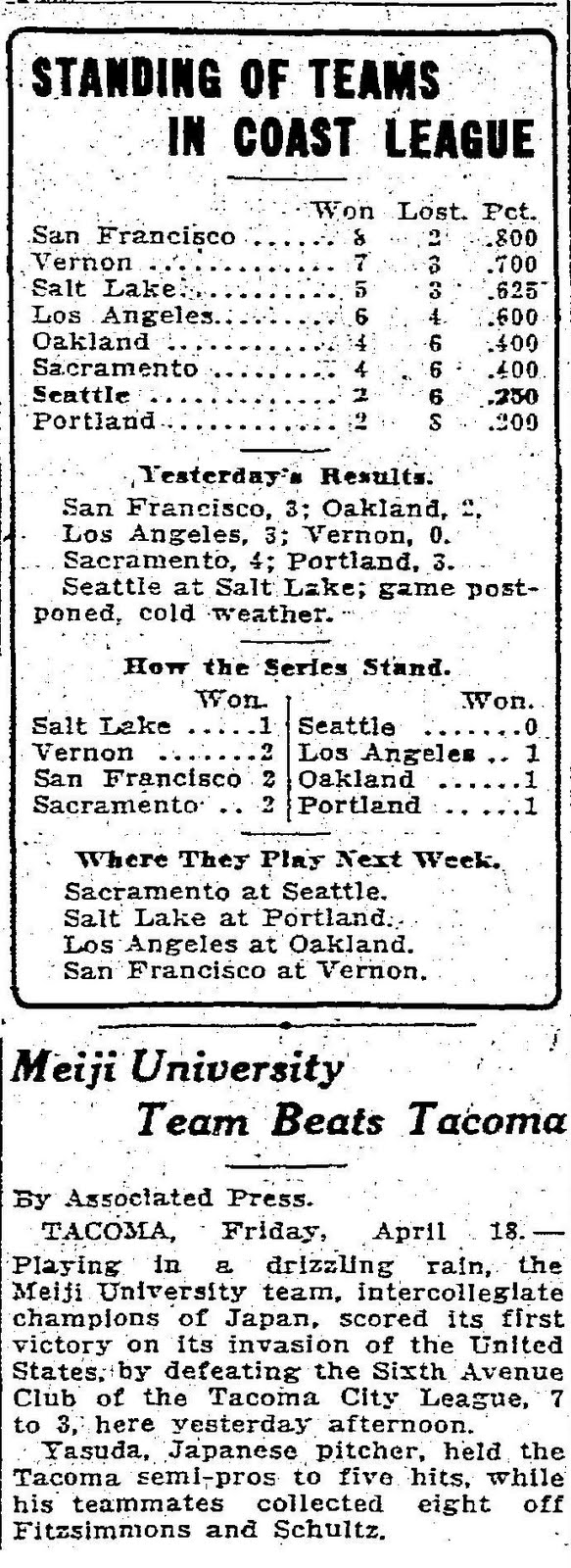Game 9, Friday, April 18, 1924
"Pigg Slaughtered". I suppose Victor Pigg never really stood a chance of avoiding that headline. In this game, former Yankees and Red Sox pitcher, and future major league outfielder, Lefty O'Doul was the winning pitcher, with the Pigg performance contributing equilaterally to an evenly dismal start of .222 after nine games. And, being a quality pitcher, O'Doul knew what to do with a 9-4 lead in the fourth inning, so there wasn't much of a reason for anyone else to pitch for SLC. With the number of extra-bases being hit at Bonneville Park, I imagine Duffy Lewis, the Bees Manager, must have appreciated being able to rest his pitching staff once in awhile. O'Doul also contributed with his bat. The Indians and Bees would play two consecutive double headers on Saturday and Sunday. The Saturday game was added due to the rain outs. Sunday was the usual day for a PCL double header.
Another rain delay on Thursday, April 17, 1924
Meiji University continued its tour, beating the Sixth Avenue Club in Tacoma. Meanwhile, the Indians faced the prospect of a second rain out in three days. They would play an extra double header over the weekend to make this up.
Game 8, Wednesday, April 16, 1924
The Indians travelled to Salt Lake City on Monday the 14th, but had a rain/snow out on the 15th. They finally kicked off the series with the Bees at hitter friendly Bonneville Park. Bill Plummer was the loser. One name to take note of is Tony Lazzerri, or as it's spelled in the box score, Lazerre. Another is Lefty O'Doul, who was working his way back to the majors after arm injuries sidelined his pitching career. A lot would happen to Lefty between this game and October 4, 1933, when he would get a single and 2 rbi's in his only career World Series at bat. Lazzeri is in the Hall of Fame, O'Doul is not. He should be. Baseball before WWII was always more than the Major Leagues and the Hall of Fame has recognized that in important ways. They should look at expanding their reach to individuals like O'Doul who do not fit into any tidy category or box. Players and managers who have exceptional contributions outside of the Majors should be recognized. Players who hit .349 for their career should be. I think O'Doul passes the HOF smell test in spite of his short playing career.
The Bees had moved to SLC in 1915, having first seen life as the Sacramento Solons. They would only last two more years in SLC (just long enough for Lazzerri to establish a record for home run excellence with 60) before moving to LA to be the Hollywood Stars, and then to San Diego to become the Padres. Although business was apparently good in 1915, by this game, only 200 fans would attend the early season games.
The box score and column were reported on Thursday, April 17. The following column is from the same day. It details more information about a second rain out that day and how that might affect the pitchers getting stronger for the season. Also, it details some biographical information about Victor Pigg, who would have a four year career in the minors, starting with Seattle and ending in the Western League with Omaha. Follow that link from the Skagit River Journal, which gives details on Pigg's family and life. By 1927-8, Pigg was playing in Bellingham for Northwest baseball legend Tealey Raymond.
The Bees had moved to SLC in 1915, having first seen life as the Sacramento Solons. They would only last two more years in SLC (just long enough for Lazzerri to establish a record for home run excellence with 60) before moving to LA to be the Hollywood Stars, and then to San Diego to become the Padres. Although business was apparently good in 1915, by this game, only 200 fans would attend the early season games.
The box score and column were reported on Thursday, April 17. The following column is from the same day. It details more information about a second rain out that day and how that might affect the pitchers getting stronger for the season. Also, it details some biographical information about Victor Pigg, who would have a four year career in the minors, starting with Seattle and ending in the Western League with Omaha. Follow that link from the Skagit River Journal, which gives details on Pigg's family and life. By 1927-8, Pigg was playing in Bellingham for Northwest baseball legend Tealey Raymond.
Week 1 Recap
The Seattle Indians finished up the first week of the season on Sunday, April 13, 1924. In spite of outscoring the Los Angeles Angels 42-34, they left for Salt Lake City and its Bees on Monday, April 14th with a 2-5 record. Of course, the only reason they had that scoring advantage was a remarkable 20-1 win to finish up their first double header of the season. When they got to SLC it was raining, and it stayed that way for both Tuesday and Wednesday.
The Seattle club had spring training in Southern California, starting at Lake Elsinore (it's along the 15, if you hate taking the 5 from LA to Sandy Eggo, you've passed it) and finishing up the spring in Los Angeles. The season started on Tuesday, April 8, with a 5-1 loss. They lost on Wednesday 6-5 and then on Thursday the 10th by a score of 8-3. The Indians were able to get into the win column finally on Friday, April 11th with a 9-5 win. Saturday saw the Indians again lose, this time 5-3. Finally on Sunday, it seemed as if the Angels tired of scoring at least five runs a game. The Angels took the opening contest 4-1, but Seattle came back with an offensive explosion in the closing game of the series, the 20-1 mentioned above.
The top of the lineup was pretty consistent:
1- Billy Lane, CF, started all 7 games going 7 for 25 with 4 runs
2- Cliff Brady, 2B, started all 7 games going 7 for 28 with 4 runs
3- Captain Sam Crane, SS, started 5 games, missing #s 2 and 3 with an injury, 7 for 22, 1 run
3- Jimmy Welsh, 3B, pinch hit twice going 1-2, started twice finishing the week 2 of 10, 1 run
4- Brick Eldred, RF, started all 7 games, going 8 for 23, scoring 5 runs
5- Elmer Bowman, 1B, started all 7 games, going 8 for 27 with 6 runs
6- Ray Rohwer, LF, hit 7th in the 6th game, went 7 for 26 with 7 runs
Frank Emmer hit 7th in the first 3 games, starting at 3B in the opener and SS in #s 2 and 3, went 2 for 10 with run. Henry 'Ted' Baldwin missed the first three games with an injury sustained finishing up spring training in Los Angeles. He came back for game 4, batting 7th, but hit 6th in game 6, going back to the 7 hole for game 7. He hit 7 for 18 and scored 4 runs.
Earl Baldwin, catcher, hit 8th for five games, and Frank Tobin, the backup catcher, did the same in games 4 and 7. Earl was 4 for 17 with 2 runs and Tobin went 5 for 8 with 5 runs.
The bottom of the lineup saw the pitchers go 3 for 29, with Bill Plummer collecting 1 hit and Suds Sutherland 3 for 7 with 2 runs.
Regarding the pitching, 39-year old MLB veteran Vean Gregg started what would be a very good season for himself (playing himself back into the majors with 1924 World Series winners the Washington Senators) by going 0-2, losing on opening day on Tuesday, and then in the front side of the double-header on Sunday. Suds Sutherland, a 30 year old pitcher and Coast League veteran who'd got one shot at the MLB in 1921 but caught the ire of Ty Cobb in spite of going 6-2 that year, lost game 2, but was the winner in game 7. Wheezer Dell, MLB veteran at the age of 38, picked up the loss in game 3. 22 year old Bill Plummer picked up one of his few career wins in game 4. Another MLB veteran, Jim Bagby, picked up a loss in game 5. Frank Osborn, who came to camp as a reserve outfielder along with George Bogart, pitched in relief 4 times that first week. Percy Jones, Carl Williams, George Steuland, and Victor Pigg also some time in relief. George Bogart would have the shortest career. The former standout at UC Davis, and 27-year old PCL rookie, would get one pinch running appearance in the ninth inning of the third game of the year and was released following the next game on Friday. The reason given by Wade Killefer was, that at the age of 27, Bogart did not appear to have much room to develop.
The Meiji Nine tour the US
In 1924, the Meiji University baseball team toured the US. They would play college teams, athletic clubs and others as they made their way across the western and central United States.
The photograph above was taken at Dugdale Park on April 20, 1924, according to notes at the University of Washington Library. At the same time the Meiji University baseball team was touring, the US was debating the passage of the exclusionary Johnson-Reed Act, yet another immigration law based on the supply of labor. The law included the National Origins Act and the Asian Exclusion Act. As always, the best parts of America were not to be found in its legislative bodies, but rather in the actions of its people, who preferred to play a game of baseball. The first Japanese team to tour the US was from Waseda University in 1905, a trip that was sponsored by the government of Japan to generate good will. At that time, the US was also in an uproar over Japanese immigration, much of it brought on by the Russo-Japanese War and Hearst Newspapers. Organized Japanese baseball, and the Japanese Socialist movement, were started by Isoo Abe. Abe had come back to Japan in 1899 after studying in the US, and brought with him baseball and radical thought. In the same year he organized a baseball team at Waseda, he participated in the first meeting of the Japanese Socialist Study Group with Shusui Kotoko.
By 1924, Japanese colleges had made at least a half-dozen tours of the US, and the tours would match them up against US colleges, high schools, and the many Issei teams up and down the west coast. Major League teams had also toured Japan. In fact, the Suquamish Indian Tribe had even toured Japan. Lots of interaction. The Suquamish story is quite interesting, but I digress. Here is the first article detailing the arrival of the Meiji team, and the second article is from April 16, four days later, and details the results of the first game.The panoramic photo above would have been taken after the two game series at Denny Park and the side trip to play the Sixth Avenue club from/at the City of Destiny.
The two teams would play again the next day, coming down to a final throw at the plate:
By 1924, Japanese colleges had made at least a half-dozen tours of the US, and the tours would match them up against US colleges, high schools, and the many Issei teams up and down the west coast. Major League teams had also toured Japan. In fact, the Suquamish Indian Tribe had even toured Japan. Lots of interaction. The Suquamish story is quite interesting, but I digress. Here is the first article detailing the arrival of the Meiji team, and the second article is from April 16, four days later, and details the results of the first game.The panoramic photo above would have been taken after the two game series at Denny Park and the side trip to play the Sixth Avenue club from/at the City of Destiny.
The two teams would play again the next day, coming down to a final throw at the plate:
Subscribe to:
Comments (Atom)











